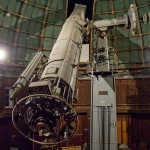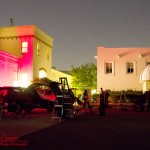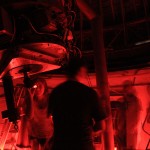The visitor directions on the website had specifically cautioned that the summit road was curvy, something I found to be a drastic understatement. From the very bottom it is curve after curve all the way up, with almost no straight sections. S-curves followed sharp bends leading to hairpins. Nearer the observatory the curve intensity only increases as the road narrows. Local history indicates that the horse-drawn wagons that transported heavy equipment up this road could not negotiate steep grades, the only solution was to follow the contour of the mountain, resulting in an incredibly curvy road.
On a sunny Saturday afternoon there were other users, the road is apparently popular with local cyclists. With the density of the sharp curves there was often little choice but to follow at bicycle speeds at times. I would much rather drive up Mauna Kea than this road again. Next time up Saddle to the summit I will recall Mt. Hamilton road and consider myself lucky.
The reason I was climbing this winding road was simply to be a tourist. Unlike the previous seven days, this day was to be fun. For much of the previous week there had been full day sessions of lectures and labs covering the intricacies of adaptive optics systems. Spending a full week in Santa Cruz might be considered a vacation, aside from the fact there had been very little open time to explore the surrounding area. There was only one open day in my travel plans, and I had specific plans for that day, a visit to an observatory.

Once the largest refracting telescope in the world, the Great 36″ Lick Refractor was completed in 1888. The entire observatory was unique in being the first major observatory to be built atop a mountain. While the idea was controversial at the time, it has proven to be an excellent one. The site is ideal, with excellent observing conditions. It is only in the last few decades that the impacts of light pollution from the nearby San Jose area have degraded the suitability of the site for astronomical research.
This telescope, and the slightly larger Yerkes 40″ represent the last and largest refractors ever built. This was the limit of the technology. Future, larger instruments would use mirrors, not lenses, to collect starlight.
The largest classic refractor I had seen before was the 24″ at Lowell. This is much larger. The dome is not all that much smaller than Keck, the long focal length required for these old refractors dictates a very large dome. The ‘scope was not only pretty to look at, but quite pleasing to look through. Later in the evening we enjoyed sights through the telescope. My years of viewing through many telescopes have given me an appreciation for decent optics. The view through this telescope was superb, excellent optics and steady air providing beautiful stellar images. Judging by the view, the celebrated lens makers, Alvan Clark & Sons., rightly deserve their reputation.
The 36″ is not the only telescope atop the mountain. At the other end of the building is the Nickel 40″ reflector. Other domes across the summit house a variety of instruments, the largest of which is the Shane 3m (120″) telescope, an instrument that is engaged in nightly research over half a century after its construction.

Lotus’ husband is a telescope technician for Lick. Keith was preparing the 3m for the night’s observing. For much of the afternoon I hung out with Kieth at the 3m telescope. Following him through the building, around and underneath. Seeing the pumps and electrical gear that keep the telescope on sky, seeing the vacuum chamber used to re-coat the mirror. The surprise was seeing the grinding machine used to originally shape the mirror along with the tool used to polish it. Most mirrors are finished elsewhere and shipped to the telescope, this mirror was ground and polished on-site.
Later we ended up in the control room where Lick support astronomer Elinor Gates was preparing for the night. She works on the adaptive optics system, an earlier version of the systems at Keck. We swapped stories and lessons into how the systems work finding we suffer from many of the same issues. A delightful conversation with folks who do much the same work, from the perspective of a sister facility.
My timing was better yet… This evening was part of the summer Music of the Spheres offered by Lick with live music. There would also be a lecture by an astronomer and viewing through telescopes large and small. Even more fortuitous, this night was the peak of the annual Perseid meteor shower.
The skies grew dark, the stars appeared, live jazz drifted through the building, and the first Perseids streaked overhead.
A number of volunteers brought their own telescopes to share the night with the crowd. Instruments ranging from small dobs, to an nice 130mm Astrophysics refractor and a 22″ Obsession were set up behind the main building. I helped set up the 22″ dob, chatting and examining design details of the new ultralight model. While light pollution from the nearby San Jose area impacted the sky, the seeing was quite good, and the views were sharp. I wish I could have spent more time with fellow amateur observers, but that would mean foregoing viewing through the historic telescopes,

During the evening we also viewed M17, the Swan Nebula. While the field was too small to see the entire nebula, the amount of detail was impressive. With the crowd it was impossible to hop around, plus it was obviously took a substantial bit of effort to reposition the big telescope. I did take a moment to step to the other end of the building where the 40″ was showing M57, the Ring Nebula, bright and clear in the field. With averted vision I could just make out the central star.
The concert and viewing over, the visitors began leaving the mountain, the volunteers quickly put away the seating and stage, cleaning up after hundreds of guests.
Lotus and her husband are planning to retire soon. In a bit of ceremony Lotus was to put the great refractor to bed for the night, stowing the huge instrument in the correct position and closing the dome. The other docents and I watched as the century old telescope was shut down with a fitting symbolism. With that we turned out the lights and headed out into the night.
Loath to actually leave, I gazed at the beautiful dark sky overhead. The day had been quite hot, the night was comfortably warm, even at 1am. For a while I hung out, chatting with the many folks about the parking lot watching the stars and ongoing meteor shower. I pointed out constellations with the laser pointer and talked about meteors. Our vigil was rewarded with a nice showing, including the occasional bright fireball. Eventually I had to leave the mountain, heading down that twisty road to a hotel. Headed for a few hours of sleep, and a flight bound back to the islands.
Before leaving I spent a few more minutes watching the sky for one last fireball.

